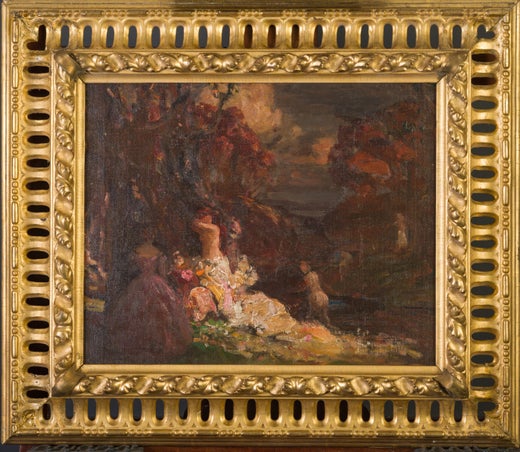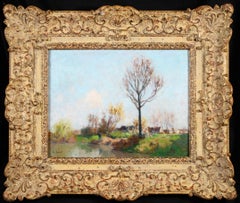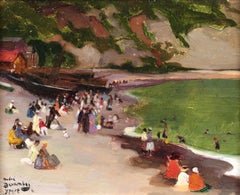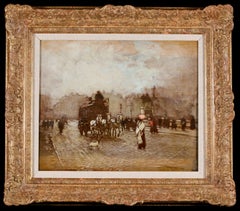Want more images or videos?
Request additional images or videos from the seller
1 of 8
Adolphe Monticelli"The Adoration of the Magi" Monticelli C.19th French Pre-Impressionist Religiousc.1870
c.1870
$4,729.58List Price
About the Item
- Creator:Adolphe Monticelli (1824 - 1886, French)
- Creation Year:c.1870
- Dimensions:Height: 13 in (33.02 cm)Width: 9 in (22.86 cm)
- Medium:
- Movement & Style:
- Period:
- Condition:Very good condition.
- Gallery Location:Marlow, GB
- Reference Number:1stDibs: LU41533395731
Adolphe Monticelli
Adolphe Joseph Thomas Monticelli, widely known as Adolphe Monticelli, was a French painter whose vibrant and expressive style preceded the Impressionist movement. Born in Marseille in 1824, Monticelli embarked on his artistic journey at the age of eighteen by attending the École Municipale de Dessin in his hometown from 1842 to 1846. He then moved to Paris to further his studies under the tutelage of Paul Delaroche at the prestigious École des Beaux-Arts. While in Paris, Monticelli honed his skills by making meticulous copies of works by the Old Masters in the Louvre and creating oil sketches inspired by Eugène Delacroix. His technique evolved significantly during this period, laying the foundation for his distinctive style. In 1855, Monticelli met Narcisse Diaz, an artist associated with the Barbizon School. The two frequently painted together in the forest of Fontainebleau. Monticelli was influenced by Diaz’s practice of incorporating nudes or elegantly dressed figures into landscapes, a motif that would recur in his own work. Monticelli developed a highly individual Romantic style characterized by richly colored, dappled, and textured surfaces. His paintings, with their scintillating effects, often depicted courtly subjects inspired by Antoine Watteau. Additionally, he created still lifes, portraits, and Orientalist scenes, drawing inspiration from Delacroix’s oil paintings. In the 1860s, Monticelli befriended the young Paul Cézanne, and his influence is evident in Cézanne’s work from that decade. Despite his growing prowess and the significant output of his work, Monticelli lived in poverty after returning to Marseille in 1870. He sold his paintings for meager sums, driven solely by his passion for art rather than financial gain. From 1878 to 1884, Monticelli and Cézanne often painted together, exploring the landscapes of Aix-en-Provence. Monticelli’s dedication to his craft was reflected in his remark, “I paint for thirty years from now,” suggesting a forward-looking vision that anticipated future artistic developments. Monticelli’s work, with its painterly freedom and expressive use of color, prefigured that of Vincent van Gogh. Van Gogh, who greatly admired Monticelli’s work after seeing it in Paris in 1886, adopted a brighter palette and heavier brushstrokes influenced by Monticelli’s style. Unfortunately, Monticelli passed away in Marseille in 1886, just a few months before Van Gogh arrived in Paris, and the two artists never met. In 1886, Monticelli’s distinctive style and technique captured the attention of critics and admirers at the Salon des XX. His nervous and broad brushstrokes, along with a remarkably rich palette, made his work instantly recognizable. He painted a variety of subjects, including imaginary festive scenes, expressive portraits, sensual nudes, vibrant still lifes, and lively circus scenes, all characterized by a unique vivacity and color that continue to be admired in the art world today. Adolphe Monticelli’s legacy is that of an influential French painter who, despite a life of poverty, left a lasting impact on the art world. His friendship with Cézanne, his influence on Van Gogh, and his vibrant, expressive style ensure that his work remains celebrated and studied long after his time.
About the Seller
5.0
Gold Seller
Premium sellers maintaining a 4.3+ rating and 24-hour response times
Established in 2001
1stDibs seller since 2016
709 sales on 1stDibs
Typical response time: 1 hour
Authenticity Guarantee
In the unlikely event there’s an issue with an item’s authenticity, contact us within 1 year for a full refund. DetailsMoney-Back Guarantee
If your item is not as described, is damaged in transit, or does not arrive, contact us within 7 days for a full refund. Details24-Hour Cancellation
You have a 24-hour grace period in which to reconsider your purchase, with no questions asked.Vetted Professional Sellers
Our world-class sellers must adhere to strict standards for service and quality, maintaining the integrity of our listings.Price-Match Guarantee
If you find that a seller listed the same item for a lower price elsewhere, we’ll match it.Trusted Global Delivery
Our best-in-class carrier network provides specialized shipping options worldwide, including custom delivery.You May Also Like
"Green Windows" (2025), Original Impressionist Still-Life, Oil Painting on Paper
By Hazel Z Weckbach
Located in Denver, CO
Hazel Z Weckbach's "Motel" is an original, hand-made oil painting that depicts an intersection, the focus being on a motel sign on the corner.
Artist Statement:
"Subject matter to m...
Category
2010s American Impressionist Still-life Paintings
Materials
Oil, Panel
"Motel" (2017), Original Impressionist Cityscape, Oil Painting on Paper
By Hazel Z Weckbach
Located in Denver, CO
Hazel Z Weckbach's "Motel" is an original, hand-made oil painting that depicts an intersection, the focus being on a motel sign on the corner.
Artist Statement:
"Subject matter to m...
Category
2010s American Impressionist Landscape Paintings
Materials
Oil, Panel
"Between" Original Impressionist Forest Landscape, Oil Painting
By Hazel Z Weckbach
Located in Denver, CO
Hazel Z Weckbach's "Between" is an original, hand-made oil painting.
Artist Statement:
"Subject matter to me is a vehicle for me to explore how I observe life. My urban influences a...
Category
2010s Impressionist Still-life Paintings
Materials
Oil, Panel
"Foot Traffic" Original Impressionist Cityscape, Oil Painting
By Hazel Z Weckbach
Located in Denver, CO
Hazel Z Weckbach's "Foot Traffic" is an original, hand-made oil painting.
Artist Statement:
"Subject matter to me is a vehicle for me to explore how I observe life. My urban influen...
Category
2010s Impressionist Still-life Paintings
Materials
Oil, Panel
"Light Reflection" Original Impressionist Landscape, Watercolor Painting
By Hazel Z Weckbach
Located in Denver, CO
Hazel Z Weckbach's "Light Reflection" is an original, hand-made watercolor painting.
Artist Statement:
"Subject matter to me is a vehicle for me to explore how I observe life. My ur...
Category
2010s Impressionist Still-life Paintings
Materials
Oil, Panel
"Green Tide" Original Impressionist Landscape, Oil Painting
By Hazel Z Weckbach
Located in Denver, CO
Hazel Z Weckbach's "Green Tide" is an original, hand-made oil painting.
Artist Statement:
"Subject matter to me is a vehicle for me to explore how I observe life. My urban influence...
Category
2010s Impressionist Still-life Paintings
Materials
Oil, Panel
Viridian's Ride
Located in Denver, CO
Valerio D'Ospina's (US based) "Viridian's Ride" is an oil painting depicting an urban street in green, at night, with a motion blur.
Valerio D’Ospina was born in Taranto in 1980. O...
Category
2010s American Impressionist Figurative Paintings
Materials
Panel, Oil
"Wild Animal" (2025) Still-Life of Medieval Armor, Oil Painting
By Elena Burykina
Located in Denver, CO
Elena Burykina's "Wild Animal" (2025) is an original, handmade oil painting on panel.
Artist Statement:
Burgundy Negrolis circle ca. 1540- ca. 1550 This remarkable Burgundian vase, ...
Category
2010s Impressionist Figurative Paintings
Materials
Oil, Panel
"Helmet for the Ghost" (2023) - Original Still-Life Painting by Elena Burykina
By Elena Burykina
Located in Denver, CO
Elena Burykina's "Totem Animal" (2023) is an original, handmade oil painting on panel.
Artist Statement:
Sallet Armorer Matthes Deutsch German ca. 1490 The unusually heavy weight of...
Category
2010s Impressionist Figurative Paintings
Materials
Oil, Panel
"Medieval Rhinoceros" (2025) Still-Life of Renaissance Armor, Oil Painting
By Elena Burykina
Located in Denver, CO
Elena Burykina's "Medieval Rhinoceros" (2025) is an original, handmade oil painting on panel.
Artist Statement:
Closed Burgonet German ca 1525-30 This helmet combines features commo...
Category
2010s Impressionist Figurative Paintings
Materials
Oil, Panel
More From This Seller
View AllSur la Plage - Impressionist Oil, Figures in Coastal Landscape by Alfred Stevens
By Alfred Émile Léopold Stevens
Located in Marlow, Buckinghamshire
Signed and dated figures in seascape oil on panel by Belgian impressionist painter Alfred Emile Leopold Stevens. The work depicts an elega...
Category
1890s Impressionist Figurative Paintings
Materials
Oil, Panel
Fishing on the Seine - Impressionist Landscape Oil Painting by Alexandre Jacob
By Alexandre Louis Jacob
Located in Marlow, Buckinghamshire
Signed oil on panel landscape circa 1940 by popular French impressionist painter Alexandre Louis Jacob. The work depicts a man fishing on the bank of the River Seine in France on a c...
Category
Mid-20th Century Impressionist Landscape Paintings
Materials
Oil, Panel
Figures on the Beach - Impressionist Oil, Coastal Landscape by Andre Devambez
By André Devambez
Located in Marlow, Buckinghamshire
Signed and titled oil on panel figures in landscape circa 1920 by French impressionist painter Andre Devambez. The piece depicts couples and families en...
Category
Early 20th Century Impressionist Figurative Paintings
Materials
Panel, Oil
Le Pont Neuf - Impressionist Figures in Landscape Oil by Amedee Marcel-Clement
By Amedee Julien Marcel-Clement
Located in Marlow, Buckinghamshire
Signed and dated figures in cityscape oil on panel by French impressionist painter Amedee Marcel-Clement. The work depicts a view of the Pont Neuf bridge that runs over the River Sei...
Category
1910s Impressionist Figurative Paintings
Materials
Oil, Panel
Le plage de Morgat - Impressionist Seascape Landscape Oil by Maxime Maufra
By Maxime Maufra
Located in Marlow, Buckinghamshire
Signed and dated impressionist oil on panel seascape painting by French painter Maxime Maufra. This stunning work depicts the beach at Morgat in Brittany, northwest France. The cryst...
Category
1880s Impressionist Landscape Paintings
Materials
Oil, Panel
Fifth Avenue & 42nd Street - American Impressionist Cityscape Oil by Guy Wiggins
By Guy Carleton Wiggins
Located in Marlow, Buckinghamshire
Signed and titled figures in cityscape oil on panel circa 1920 by American impressionist painter Guy Carleton Wiggins. This wonderful piece depicts a view of the New York Public Library in the United States of America during a winter snowstorm. Several cars and pedestrians can be seen passing along Fifth Avenue. A fantastic work in the artist's distinctive style.
Dimensions:
Framed: 16"x18"
Unframed: 8"x10"
Provenance:
Roughton Galleries - Texas. This work is included in the catalogue raisonne under reference number GW00179
Guy Carleton Wiggins was the son of Carleton Wiggins, a painter of landscapes and animals. Wiggins first studied at his father's Art School in Connecticut and later enrolled in the National Academy of Design where he trained with William Merritt Chase and Robert Henri, after a brief spell studying architecture at the Polytechnic Institute in Brooklyn. At the age of 20 he was already well known and was the youngest American artist to have a work accepted for the permanent collection of the Metropolitan Museum in New York. Prior to the onset of World War I, Wiggins travelled to Europe and painted the English countryside. In England he met his future wife Dorothy Stuart Johnson. The couple returned to the US and set up home in Connecticut. He established a year-round art school, the Guy Wiggins Art School, in Essex. He liked to spend his winters in New York and summers in Connecticut. Wiggins' paintings reflect the influence of American Impressionism, a style of painting he would have encountered during his summers in Old Lyme. He is known for his snowy New York...
Category
Early 20th Century American Impressionist Figurative Paintings
Materials
Oil, Panel
Recently Viewed
View AllMore Ways To Browse
Antique Masquerade
Adoration Magi
Adoration Of The Magi
Pre Impressionist
Oil Painting Still Life With Parrot
Elegant Large Nude Oil Painting
Italian Landscape Painting 19th Century G
Religious Art Panels
Antique Garden Carts
Montreal Oil
Paul Guigou
King David Painting
Louise Feneley
Lowry Oil
Lucile Blanch
Manuel Angeles Ortiz
Mike Rivero
Miro Oil Paintings



